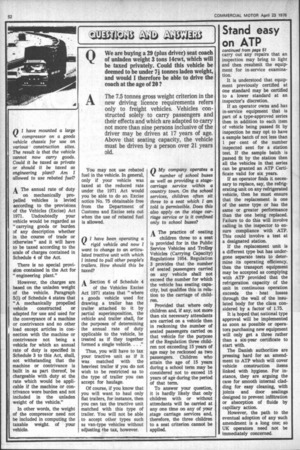Stand easy
Page 54

If you've noticed an error in this article please click here to report it so we can fix it.
on ATP continued from page 51 carry out any repairs that an inspection may bring to light and then resubmit the equipment for in-service examination.
It is understood that equipment previously certified at one standard may be certified to a lower standard at an inspector's discretion.
If an operator owns and has in-service equipment that is part of a type-approved series then in addition to each item of vehicle being passed fit by inspection he may opt to have a sample batch of not less than 1 per cent of the number inspected sent for a station test. If the sample batch is passed fit by the station then all the vehicles in that series can be granted an ATP Certificate valid for six years.
If an operator finds it necessary to replace, say, the refrig erating unit on any refrigerated vehicle, then he must ensure that the replacement is one of the same type or has the same or greater performance than the one being replaced.
Failure to do this will involve calling in the inspector to ensure compliance with ATP. This could involve a test at a designated station.
If the replacement unit is a different type but has under gone separate tests to deter mine its operating efficiency, then the transport equipment may be accepted as complying with ATP provided that the refrigeration capacity of the unit in continuous operation exceeds the heat losses through the wall of the insulated body for the class considered by a factor of 1.75.
It is hoped that national type approval will be implemented as soon as possible or opera tors purchasing new equipment will only get a three rather than a six-year certificate to start with.
The Danish authorities are pressing hard for an amend ment to ATP which will cover vehicle construction items linked with hygiene. For instance, they are arguing the case for smooth internal cladding for easy cleaning, with joints and door sealings designed to prevent infiltration or absorption of fluids by capillary action.
However, the path to the eventual adoption of any -such amendment is a long one; so UK operators need not be immediately concerned.
































































































